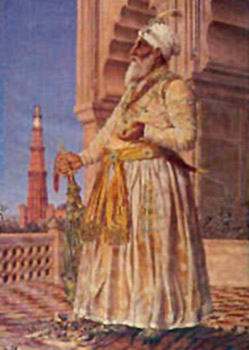 Nawabs of Awadh are the richest cultural heritage of the great city. Also known as the city of Nawabs, Lucknow, which was a part of the ancient city of Awadh, has had a long tradition of Nawabi rule which has added to the grandeur and magnificence of the city. The tradition of Nawabi rule started with the advent of Mughal rule in the region. Discussed below are the various Nawabs of Awadh in chronological order.
Nawabs of Awadh are the richest cultural heritage of the great city. Also known as the city of Nawabs, Lucknow, which was a part of the ancient city of Awadh, has had a long tradition of Nawabi rule which has added to the grandeur and magnificence of the city. The tradition of Nawabi rule started with the advent of Mughal rule in the region. Discussed below are the various Nawabs of Awadh in chronological order.
Saadat Khan
Of all the dependencies of the Mughal Empire, Awadh had the newest dynasty whose founder was the descendant of a noble family of Nishapur in Khurasan. Mir Muhammad Amin, entitled Saadat Khan, was the son of Mir Nasir who came to India in 1707. At first, Mir Muhammad Amin entered the service of an Amil and later joined Sarbuland Khan, Faujdar of Kara Manikpur. His extraordinary performance soon elevated him to a Mansab under Farrukh Siyar, who became emperor in 1713.
Muhammad Amin was instrumental in the accession of Muhammad Shah and the overthrow of the Saiyyid brothers, Abdullah Khan and Husain Ali, who attempted to become king-makers. Consequently, he was favoured with rapid promotions and was given the title of Saadat Khan Bahadur in 1720. On the transfer of Raja Girdhar Nagar to Malwa on 9 September 1722, he was appointed governor of Awadh. Although he continued to be interested in the politics of the Mughal court, he played decisive roles in the affairs of Awadh in general and Lucknow in particular.
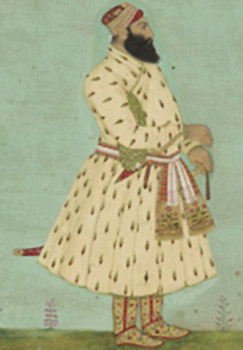 The city of Lucknow was the stronghold of the Shaikhzadas, whose unruly attitude was causing concern to the Mughal emperor. For establishing his supremacy as governor of Awadh, Saadat Khan made a diplomatic alliance with the Shaikhs of Kakori. He was able to defeat the Shaikhzadas and reduced them to submission. This event was followed by the submission of several chieftains and aggressive Zamindars of the area to the Mughal authority. The Mughal emperor conferred on Saadat Khan the title of Burhan ul Mulk (symbol of the state).
The city of Lucknow was the stronghold of the Shaikhzadas, whose unruly attitude was causing concern to the Mughal emperor. For establishing his supremacy as governor of Awadh, Saadat Khan made a diplomatic alliance with the Shaikhs of Kakori. He was able to defeat the Shaikhzadas and reduced them to submission. This event was followed by the submission of several chieftains and aggressive Zamindars of the area to the Mughal authority. The Mughal emperor conferred on Saadat Khan the title of Burhan ul Mulk (symbol of the state).
Saadat Khan consolidated his position very soon. Peace was now ensured for the inhabitants, and highways were secure for caravans. These factors resulted in the growth of trade and commerce. He mostly resided at Ayodhya and Lucknow. He chose the fish as his emblem and it later became the most popular symbol of Awadh, appearing on gates, doorways and cornices of official and private buildings for more than two hundred years.
Safdar Jang
Saadat Khan died on 19 March 1739, and his son-in-law, Muhammad Maqim, who had been his deputy between 1724 and 1739, succeeded him. He was given the title of Abul
Mansur Khan by the emperor. Muhammad Maqim had already distinguished himself by achieving notable success in every expedition led by Burhan ul Mulk, gaining the post of
Mir Atish or Superintendant of the Royal Artillery. The Mughal emperor Ahmad Shah Bahadur appointed him as Wazir on 29 June 1748, with the title of Safdar Jang. The Afghan Nawab Ahmad Khan Bangash of Farrukhabad had become rather powerful during this time and even went on to defeated the forces of the Wazir and occupied Lucknow. However, they were soon overthrown by the Shaikhzadas of Lucknow who could not tolerate the atrocities committed by the Bangash officials. Consequently, Awadh again came under the administration of the Nawab Wazir. The palaces of the Shaikhzadas of Lucknow which were taken over by Nawab Saadat Khan `Burhan ul Mulk` were finally declared the property of the Nawab Wazir by Safdar Jang and the Shaikzadas were granted seven hundred acres of land in Dugawan, in exchange. Soon, Safdar Jang had to leave for Delhi where conspiracies against him were rampant. Safdar Jang died on 5 October 1754, while struggling to reconsolidate his position.
Shuja ud Daula
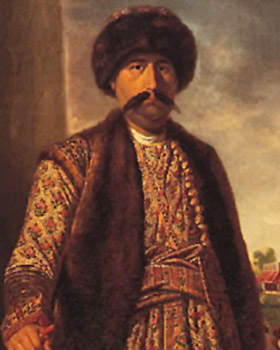 Safgdar Jang`s son, Shuja ud Daula, succeeded him to the Wazirat. He lived mostly at Faizabad. During this period the Nawab was subjected to frequent interference by the British who curtailed his freedom with regard to the maintenance of troops and the signing of treaties with other regional rulers. The British extracted fifty lakhs of rupees from Shuja ud Duala and appointed a Resident at Lucknow. In spite of interference by the British, Shuja ud Daula administered Awadh well. The economy of the province continued to flourish and the city of Faizabad was adorned with stately buildings, both secular and religious. Lucknow also continued to enjoy agrarian and commercial prosperity. Shuja ud Daula died on 26 January 1775, at the age of forty-three, leaving a full treasury supported by abundant revenue.
Safgdar Jang`s son, Shuja ud Daula, succeeded him to the Wazirat. He lived mostly at Faizabad. During this period the Nawab was subjected to frequent interference by the British who curtailed his freedom with regard to the maintenance of troops and the signing of treaties with other regional rulers. The British extracted fifty lakhs of rupees from Shuja ud Duala and appointed a Resident at Lucknow. In spite of interference by the British, Shuja ud Daula administered Awadh well. The economy of the province continued to flourish and the city of Faizabad was adorned with stately buildings, both secular and religious. Lucknow also continued to enjoy agrarian and commercial prosperity. Shuja ud Daula died on 26 January 1775, at the age of forty-three, leaving a full treasury supported by abundant revenue.
Nawab Asaf ud Daula
After Shuja ud Daula became the most popular Wazir of the empire, Nawab Asaf ud Daula who transferred his seat of government from Faizabad to Lucknow. According to the Tarikh Farha Bakhsh, the process of transfer commenced from the very first year of his accession. Four months after his accession, Asaf ud Daula had to sign a fresh treaty with the British on 21 May 1775. While it affirmed "friendship and perfect union" between the Nawab and the British East India Company, it also stipulated that the Nawab should employ no Europeans without the sanction of the Company that neither party should consent to any proposals made to it by the emperor of Delhi against the other, that Kara and Allahabad should always remain in possession of the Nawab, and (Varanasi) Jaunpur, Ghazipur and other possessions of Raja Chet Singh, yielding an annual revenue of twenty-three lakhs, should be ceded to the Company. Also, all arrears due against Asaf ud Daula`s father were to be paid by the Nawab. The Company on its part undertook to defend Awadh, Kara, Allahabad and the recent acquisitions of Shuja ud Daula in Rohilkhand and the Doab.
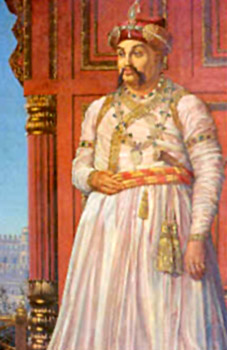 According to Mirza Abu Talib, the annual revenue of Lucknow was far more than that of
Delhi and Varanasi, which is why the Company continued to increase their claims from
the Nawab of Awadh. Moreover, Delhi was already robbed of its grandeur and wealth. Sir John Shore, Governor General, visited Lucknow in 1797 and forced Nawab Asaf ud Daula to pay five and a half lakhs of rupees per annum to the Company for the maintenance of additional troops, both of Indian and European origin. The Nawab was not inclined to accept the demand. He fell seriously ill soon thereafter, and refusing to take medicines, died a few days later, on 20 September 1797. He was laid to rest in his celebrated Bara Imambara. Asaf ud Daula was responsible for the overall development and extension of the city of Lucknow, and built several stately edifices and ornamental gardens, which still give their names to the old Mohallas.
According to Mirza Abu Talib, the annual revenue of Lucknow was far more than that of
Delhi and Varanasi, which is why the Company continued to increase their claims from
the Nawab of Awadh. Moreover, Delhi was already robbed of its grandeur and wealth. Sir John Shore, Governor General, visited Lucknow in 1797 and forced Nawab Asaf ud Daula to pay five and a half lakhs of rupees per annum to the Company for the maintenance of additional troops, both of Indian and European origin. The Nawab was not inclined to accept the demand. He fell seriously ill soon thereafter, and refusing to take medicines, died a few days later, on 20 September 1797. He was laid to rest in his celebrated Bara Imambara. Asaf ud Daula was responsible for the overall development and extension of the city of Lucknow, and built several stately edifices and ornamental gardens, which still give their names to the old Mohallas.
Wazir Ali
Asaf ud Daula was succeeded by his son Wazir Ali, whose accession was challenged by his uncle Sadat Ali, on grounds of his spurious birth, but Wazir Ali`s claim was accepted by the British. However, Sir John Shore`s constricting policies annoyed Wazir Ali who enjoyed his freedom. As a result he was superseded by Sadat Ali Khan, who agreed to please the Governor General.
Sadat Ali Khan
Sadat Ali Khan was summoned from Varanasi and proclaimed Nawab Wazir on 21 January 1798, and a treaty of seventeen articles was signed in pursuance of the previous understanding between him and the Governor-General. The Nawab had to give up the Allahabad Fort and pay rupees eight lakhs for its repairs. Moreover, the annual subsidy paid by the Nawab Wazir, which amounted to over fifty-six lakhs, was now raised to seventy-six lakhs. The Nawab had to surrender the districts of Rohilkhand, Farrukhabad, Mainpuri, Etawah, Kanpur, Fatehgarh, Allahabad, Azamgarh, Basti and Gorakhpur. Sadat Ali Khan was an efficient administrator and undertook a number of policies for the welfare of the people. In spite of the high-handed policies of the British, Nawab Saadat Ali Khan left a full treasury.
Ghaziuddin Haidar
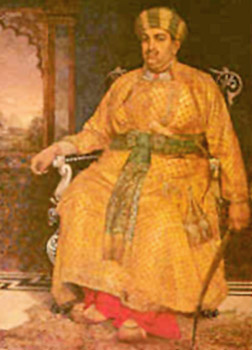 Nawab Saadat Ali died in July 1814, and was succeeded by his son, Ghaziuddin Haidar. The British again resorted to new methods of obtaining benefits from the flourishing treasury of Awadh. In 1814, a million rupees were borrowed for the Nepal war. A second million was borrowed the following year, but this debt was liquidated in 1816 by the accession of Khairgarh and the Terai area of the foothills of Nepal, Ghaziuddin Haidar also presented to the Company a fully-equipped regiment of cavalry at his own expense and supplied a large number of elephants as well. The Nawab was an able administrator and Lucknow was rather peaceful under his reign. He was a learned man fond of studies in Philology and Philosophy. He also had a strong taste for mechanics and chemistry.
Nawab Saadat Ali died in July 1814, and was succeeded by his son, Ghaziuddin Haidar. The British again resorted to new methods of obtaining benefits from the flourishing treasury of Awadh. In 1814, a million rupees were borrowed for the Nepal war. A second million was borrowed the following year, but this debt was liquidated in 1816 by the accession of Khairgarh and the Terai area of the foothills of Nepal, Ghaziuddin Haidar also presented to the Company a fully-equipped regiment of cavalry at his own expense and supplied a large number of elephants as well. The Nawab was an able administrator and Lucknow was rather peaceful under his reign. He was a learned man fond of studies in Philology and Philosophy. He also had a strong taste for mechanics and chemistry.
Nasiruddin Haidar
Ghaziuddin Haidar died on 18 October 1827, and his son Nasiruddin Haidar ascended the throne. He was regarded as a very benevolent prince by the people of Awadh, and his generosity is remembered in Lucknow even today. During his reign he granted a monthly allowance of three thousand rupees to the students of the Lucknow College. He built two big hospitals - the Shahi Yunani Shafa Khana and the Darush Shafa, which provided free medical treatment, lodging and food for the poor. He also built a Sehatkhana for lepers at
Badshah Nagar. He is said to have prohibited the buying and selling of slaves, a practice which, though rare in Awadh, was still prevalent in several parts of India. Moreover, he made zealous efforts to provide for the protection and security of his people. Nasiruddin Haidar died suddenly on 7 July 1837 and his step-mother, Padshah Begum, placed her son Munna Jan on the throne in the Lal Baradari.
Muhammad Ali Shah
During this time the British again repeated their intervening role and crowned Muhammad Ali Shah the King of Awadh and made him pay one lakh sixty thousand pounds per annum. Muhammad Ali Shah introduced several administrative reforms. He succeeded in reviving the Amani system of revenue (the direct collection of taxes by the state officials) introduced by Nawab Saadat Ali Khan, over a portion of the territory, a system of revenue which earned him thirty-five lakhs of rupees.
Amjad Ali Shah
Muhammad Ali Shah died on 16 May 1842, and was laid to rest in his magnificent Imambara at Husainabad. His son Amjad Ali Shah became the king and reigned peacefully for five years. He was responsible for the construction of the fashionable market at Hazratganj and the Imambara of Sibtainabad in which he was buried upon his death on 13 February 1847.
Wajid Ali Shah
The last king of Awadh was his son, Wajid Ali Shah, whose fame as a lover of art, poetry, drama and music has survived till this day. He himself was a poet, composing verse in pure Urdu language. His monumental palaces and gardens, namely the Kaisar Bagh complex and Chhatar Manzil, are part of the celebrated architectural heritage of Lucknow.
Thus discussed above is a brief account of the various Nawabs who held sway over Awadh. The Nawabs are an integral part of the culture of Lucknow and the city is still known for the grandeur and glory of the Nawabs long gone.



















